- Clone
- SHM14 (See other available formats)
- Regulatory Status
- RUO
- Other Names
- MADM, KUZ, alpha-secretase
- Isotype
- Mouse IgG1, κ
- Ave. Rating
- Submit a Review
- Product Citations
- publications
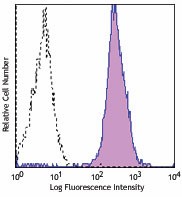
-

Human peripheral blood lymphocytes were stained with ADAM10 (SHM14) PE (filled histogram) or mouse IgG1, κ PE isotype control (open histogram).
| Cat # | Size | Price | Quantity Check Availability | Save | ||
|---|---|---|---|---|---|---|
| 352703 | 25 tests | 153 CHF | ||||
| 352704 | 100 tests | 360 CHF | ||||
CD156c, also known as a disintegrin and metalloproteinase domain-containing protein 10 (ADAM10), is a 748 amino acid type I membrane glycoprotein ubiquitously expressed on most cell types. It consists of multiple functional domains, including a N-terminal prodomain, catalytic domain, cysteine-rich domain, transmembranous domain, and cytoplasmic domain. It is secreted as a precursor protein and becomes as the activate/mature form through removing the ADAM10 prodomain by proprotein convertase 7 and furin. ADAM10 functions as metalloproteinase to cleave several molecules including Notch, pro-TNF-α, amyloid precursor protein, myelin basic protein, and type IV collagen. It mediates the release of several cell adhesion molecules such as vascular endothelial cadherin or L-selectin to regulate endothelial permeability and leukocyte transmigration. Dysregulation of ADAM activity may contribute to the pathogenesis of vascular diseases.
Product DetailsProduct Details
- Reactivity
- Human
- Antibody Type
- Monoclonal
- Host Species
- Mouse
- Immunogen
- Human A375 cell lines
- Formulation
- Phosphate-buffered solution, pH 7.2, containing 0.09% sodium azide and BSA (origin USA)
- Preparation
- The antibody was purified by affinity chromatography and conjugated with PE under optimal conditions.
- Concentration
- Lot-specific (to obtain lot-specific concentration and expiration, please enter the lot number in our Certificate of Analysis online tool.)
- Storage & Handling
- The antibody solution should be stored undiluted between 2°C and 8°C, and protected from prolonged exposure to light. Do not freeze.
- Application
-
FC - Quality tested
- Recommended Usage
-
Each lot of this antibody is quality control tested by immunofluorescent staining with flow cytometric analysis. For flow cytometric staining, the suggested use of this reagent is 5 µl per million cells in 100 µl staining volume or 5 µl per 100 µl of whole blood.
- Excitation Laser
-
Blue Laser (488 nm)
Green Laser (532 nm)/Yellow-Green Laser (561 nm)
- Product Citations
- RRID
-
AB_10900811 (BioLegend Cat. No. 352703)
AB_10896790 (BioLegend Cat. No. 352704)
Antigen Details
- Structure
- Consist of signal sequence, a N-terminal prodomain followed by a catalytic proteinase domain containing a zinc-binding motif, a disintegrin, cysteine-rich transmembrane, and a cytoplasmatic domain
- Distribution
-
Ubiquitously expressed on most of the cell types
- Function
- Acts as an efficient α-secretase
- Interaction
- Proteolysis the amyloid precursor protein (APP)
- Cell Type
- B cells, Dendritic cells, Tregs
- Biology Area
- Cell Adhesion, Cell Biology, Immunology, Innate Immunity, Neurodegeneration, Neuroscience, Protein Misfolding and Aggregation, Signal Transduction
- Molecular Family
- Adhesion Molecules, CD Molecules
- Antigen References
-
1. Edwards DR, et al. 2008. Mol. Aspects Med. 29:258.
2. Anders A, et al. 2001. FASEB J. 15:1837.
3. Endres K, et al. 2010. FEBS J. 277:1585.
4. Mochizuki S, et al. 2007. Cancer Sci. 98:621. - Gene ID
- 4684 View all products for this Gene ID
- UniProt
- View information about CD156c on UniProt.org
Related Pages & Pathways
Pages
Related FAQs
- What type of PE do you use in your conjugates?
- We use R-PE in our conjugates.
Customers Also Purchased
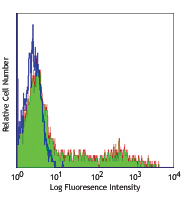
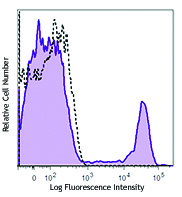
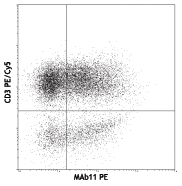
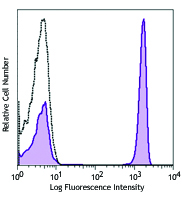
Compare Data Across All Formats
This data display is provided for general comparisons between formats.
Your actual data may vary due to variations in samples, target cells, instruments and their settings, staining conditions, and other factors.
If you need assistance with selecting the best format contact our expert technical support team.
 Login / Register
Login / Register 













Follow Us